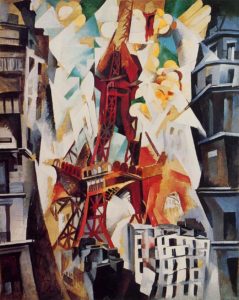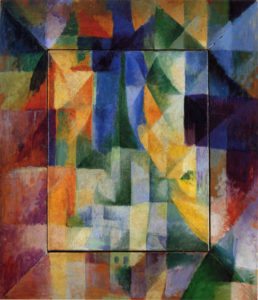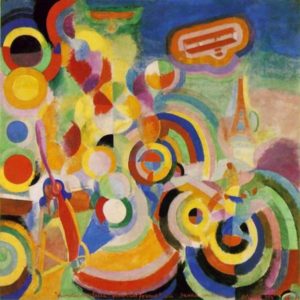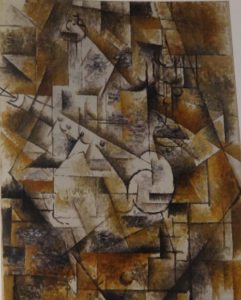Cubism After Cubism
Part One: Theories of Pre-War Orphism
Before the Great War, there were camps occupying various terrains within the art movement called “Cubism.” The name, as is well-known, was a bon mot coming either from Henri Matisse or Louis Vauxcelles, both startled by a suite of 1908 paintings by Georges Barque, containing a tumbling of ochre “cubes.” The term “Cubism” was more descriptive and dismissive than a formal designation, but, as words have a habit of doing, the catchy term stuck. When art history began its serious writing of the age of Cubism, several decisions were made in terms of delineation of the topic. Constructing from the standpoint of hindsight and from the site of New York City, where Les Demoiselles d’Avignon (1907) wound up, hanging in the Museum of Modern Art, art historians marked the “beginning” of “Cubism” from that one large painting and situated “Cubism” within the art of Pablo Picasso and his partner Georges Braque. Everything and everyone else was labeled as “minor,” leaving a substantial amount of works thought of as “Cubist” in their own time stranded outside of their own history. Only slowly has an accurate picture of Cubism begun to emerge in the past twenty years, mostly in the form of monographs and the occasional retrospective of long-forgotten artists. Juan Gris and Fernand Léger managed to capture some historical attention but solid works about the other Cubist artists are few and sparse. In addition, there has been but fleeting attention paid to the very real differences between Picasso and Braque and their colleagues who exhibited in the public salons. Critical interpretations made of the movement during the pre-war period used the term “Cubism” broadly and inclusively, referring obliquely to the fact that two of the important artists were unavailable for public viewing on the scale of a salon. An exception to that rule was Orphism, partitioned off from the Salon Cubists by a strong inclination towards abstraction and from Picasso and Braque by the deep study of color. One of the major defenders of Cubism, Guillaume Apollinaire (1880-1918), singled out Orphism for separate discussion–one of the few times a critic attempted to make distinctions among the large numbers of practicing “Cubists.”

Robert Delaunay. Champs de Mars. La Tour rouge (1911)
As a historian of the poetic and critical works of Apollinaire, Timothy Matthews pointed out in Reading Apollinaire: Theories of Poetic Language (1987), the poet was deeply concerned with modernism or with modernity and its conditions of dynamism and speed and change. His deep awareness of the unprecedented nature of twentieth-century society in the urban city of Paris fueled his early engagement with Italian Futurism. In other words, far more than Picasso and Braque, the Futurists were engaged with the cultural conditions, political and economic, of their time. These artists, in common with the modern poets, such as Apollinaire, were searching for and developing an appropriate visual language for an era of fast cars, soaring airplanes and tall buildings. In 1913, Apollinaire published Meditations esthétiques which was subtitled Les Peintres cubistes. As Laurence Campa explained in Le Monde diplomatique , Apollinaire wrote, “‘I like the art of to-day because I love light above all things, and all men above all love light, they have invented fire.’ This light Apollinaire finds in the canvases of Delaunay, especially in the series of Windows, a stunning spectacle which gives rise to the poem of the same name, Les Fenêtres, as a kaleidoscope of words: From red to green all yellow is dying.'”

Robert Delaunay. Simultaneous Windows on the City (1912)
This small eloquent book was more of a work of poetry or poetic prose than a work of art criticism or an attempt to explain Cubism. Apollinaire, as was mentioned earlier, used painting as a surrogate for poetry, thinking of advanced poets and artists as partners in the quest to bend conventional language for the needs of modernism. In an uncharacteristically clear paragraph, he wrote,
The picture will inevitably exist. The vision will be complete, complete and its infinite, instead of marking an imperfection, will only bring out the relationship of a new creature to a new creator and nothing else.Otherwise, there will be no unity, and the relations which the various points of the canvas will have with different geniuses, with different objects, with different lights, will show only a multiplicity of disparities without harmony.
Apollinaire continued, in Meditations esthétiques,
Verisimilitude is no longer important, for everything is sacrificed by the artist to the truths, to the necessities of a higher nature which he supposes without discovering. The subject no longer counts or counts. We thus proceed towards an entirely new art, which will be to painting, as we have hitherto envisioned, what music is to literature. It will be pure painting, just as music is pure literature. The music-lover experiences, on hearing a concert, a joy of a different order from the joy he experiences in listening to natural sounds like the murmur of a stream, the crash of a torrent, the whistling of the wind In a forest, or the harmonies of human language founded on reason and not on aesthetics. Modern art generally rejects most of the means of pleasing put into practice by the great artists of the past.
This passage is a succinct description of Orphism. But in the following passage, the issue of Cubism as Orphism become muddied, for the poet inexplicably inserted Picasso in a random sentence that was interesting but had nothing to do with the comparison he was making between color and music:
Young painters in extreme schools have the secret goal of painting pure. This is an entirely new plastic art. It is only at its beginning and is not yet as abstract as it wishes to be. Most new painters do well mathematics without knowing it, but they have not yet abandoned nature that they patiently question for this purpose that it teaches them the road of life. A Picasso studies an object as a surgeon dissects a corpse. This art of pure painting, if it succeeds in emerging entirely from the old painting, will not necessarily cause the disappearance of the latter, any more than the development of music has caused the disappearance of the different literary genres, Nor has the pungency of tobacco replaced the taste of food.
Later on in the book, Apollinaire arrived at the concept of the fourth dimension, which, by the time he was writing, was no longer a concern for Braque and Picasso who had back away from abstraction in favor of the materiality of mixed media. Painters have been led naturally and, so to speak, by intuition, to concern themselves with new possible measures of the extent which in the language of the modern workshops all were referred to collectively and briefly by the term of the fourth dimension. In reading this early book, written in the midst of swirling ideas about painting and poetry, one becomes aware of the struggle on the part of Apollinaire to organize what he was both seeing in studios and what he was trying to execute with his own poetry. This book is often quoted in part, the parts that seem to describe Cubism, but those sections are spare and intermittent. In between, certain lucid passages, Apollinaire meditated—as he said he was—upon the arts, music, poetry and painting and the need for a new aesthetic or definition or purpose. Trying to distinguish among the various manifestations of Cubism, he divided the movement (strangely) into parts, only one of which had any currency as of the writing of the book: “‘Orphic cubism’ is the other great trend of modern painting. It is the art of painting new ensembles with elements borrowed not from the visual reality, but entirely created by the artist and endowed by him with a powerful reality. The works of the Orphic artists must simultaneously present a pure aesthetic approval, a construction that falls under the senses and a sublime meaning, that is, the subject. It is pure art.”
Robert Delaunay. Homage to Bleriot (1914) The main point of this passage is “pure art,” which within the Orphism of Robert Delaunay, refers to the concept of “simultaneity.” For poets and painters, the term “simultaneity” indicating a combination of association and memory and spontaneous visual and cognitive experiences emerged to explain the endeavors of Robert Delaunay (1885-1941), a Parisian artist, and his associates before the Great War. Matthews quoted Apollinaire as writing that modern painting turned away from its traditional task of copying nature and moved towards plastic means of expressing–not Renaissance solutions to mimesis–but painting as an independent activity in and of itself: “the autonomy of the artistic artefact.” As Apollinaire said, “We must forget exterior reality and our knowledge of it in order to create the new dimensions, the order and extent of which will be discovered by our artistic sensibility in relation to the world of plastic creation.” By 1912 and 1913, the poet became deeply involved with the work Delaunay, who had begun the long process of conceptualizing and theorizing the aims of his own paintings in relation to the other prominent artists exhibiting in Paris. Delaunay understood what the Cubists, whether Picasso and Braque in their studios or Albert Gleizes and Jean Metzinger in the Salons, were attempting to convey–an expansion of dimensions from two and the illusion of three to the insistence upon a fourth dimension: the passage of time itself and its imprint on experience and memory rendered conceptually on a flat canvas. Georges Braque. Still Life with Clarinet (Bottle and Clarinet) (1911) But Delaunay seemed to want to also “respond to a present expressed in transformational technology.” Although it would be tempting to stop at this point because Delaunay was involved in his Ville series, incorporating the modern sights of Paris, from the old Eiffel Tower, now recognized as “new,” to biplanes, zipping through the clouds above, his intentions were much deeper than a mere representation of modern life and all of its novelties. Matthews explained, This desire is articulated in relation to the urban environment and the urban experience, and to the iconography of the technologized world of mass communication. This involvement with movement and with the experience of modernity, combined with Delaunay’s Orphism as a reaction against a certain austerity and impersonality in Cubism. It is argued that this reaction forms the initial impetus in Delaunay’s desire to develop Cubism more radically and to extend the scope of art in the post-representational era. Even Delaunay’s approach is taken purely as a reaction against Cubist ‘austerity,’ what becomes increasingly explicit in Delaunay’s approach is a concentration on color–a desire to reverse the Cubist tendency to exclude this plastic element from its productions. But to respond to Delaunay’s contribution in terms of a rejection of the Cubist ‘analytical’ style is to suggest that all original and creative art is fundamentally anti-conceptual.” According to Matthews, Delaunay “seems to have regarded Cubist productions as a necessary destruction of the restrictions exercised by perspective. For Delaunay, Cubism provided a definitive rejection of Classical forms. What Delaunay focused on, starting in 1912 and continuing after the war in his writings in 1924, was the key weakness of Cubism as practiced by Picasso, Braque, and even the Salon Cubists, was their concentration on the object itself and the “breaking up” or “fragmentation” of the object from a singular focal point. In other words, the Cubist artists trapped themselves within perspective, replacing one system with another, but still mired in the terms of the Renaissance. “Ainsi le cubisme croyant apporter un nouveau langage–expressif–ne faisait qu’apporter une modification extériure dans un système qu’il n’abolisait pas–mais qu’il soutenait: l’introduction de pluisiers points de vue d’un object sur la toile ressortissait de la même vision sinon complétée.” Delaunay also dismissed Futurism, locating its fundamental weakness, that of imitating speed and simultaneity, rather than expressing these modern qualities in a plastic manner. For Delaunay, the approach to capturing the uniqueness of modernity sould be simultaneity as manifested through color. Color, like music, is abstract, is a language in its own right. Furthermore, color can be freed from its Renaissance task of imitation of nature and can explore its inherent plastic possibilities. Matthews stated, “It is though, for Delaunay, the canvas is experience–of identity, of the present. The reading it demands of the viewer and the painter, its manipulation of the displacement that constitutes the relation of color to light, efface the contours of the painting itself..each painting is experience, it contrasts represent the pursuit of contrast and difference, the sensation of light and the ‘otherness’ of time. Thus, with the paintings of Delaunay, color is the fact and process of transition, meaning that the canvas itself become experience. As Apollinaire explained it, for Delaunay the basic condition of color is its complementary color; and, because the existence of red, for example, is conditional upon its opposite color, green, the colors cannot be separated. If they cannot be thought of as separate, colors, plural, can only be material perception or experience. It can be assumed that, at some point, Delauany went beyond his 1912-1913 quarrel with Analytic Cubism and Futurism and continued developing his own independent theories about color in painting and the problem of painting modernity. Picasso and Braque gave up monochrome painting between 1912 and 1914 in favor of experimenting with collage and pasted paper and neither of the artists returned to the incomprehensible hermetic monochromatic Cubism of their early years. Robert Delaunay and Apollinaire apparently took their stands on modern art and its competing styles and approaches far more seriously than either Braque of Picasso, for the two allies parted company over Apollinaire’s reluctance to dismiss Futurism entirely, while Delaunay rejected Futurism completely. Robert Delaunay. Disque simultané (1912) In his 1982 book, The Structure of Modernist Poetry, Theo Hermans noted that Apollinaire, in effect, separated Orphism from the rest of Cubism by linking it to Impressionism and post-Impressionism, which studied color as light and color in terms of contrast respectively. Orphism abandoned mimesis for the purity of contrasting colors and, according to Hermans, Apollinaire understood Orphism to be the natural successor to Cubism because simultanism was the “ultimate goal” of avant-garde art. As Hermans said, correctly, “Apollinaire’s comments on the Cubist painters are to be approached with some caution,” and noted that the poet “defended the new painters out of a sense of solidarity rather than conviction; his interest also shifted fairly from Cubism proper to Robert Delaunay’s Orphism.” The author noted that the artists were not particularly impressed with Apollinaire’s book, “a book which is often more lyrical than informataive on the subject of Cubism.” When Apollinaire
Obviously, Delaunay was intent on staking out his own place and was making claims for his own art and that of his two allies, Sonia Terk-Delaunay (1885-1975) and František Kupka (1871-1957). And for a time, Guillaume Apollinaire was his ally and was an interpreter (and often the mouthpiece) of the painter’s philosophy. Although the poet and painter ultimately parted company, they were not to be reconciled. The Great War began, scattering the artists, sending Delaunay and his wife Sonia Terk-Delaunay to the neutral nations of Spain and Portugal to wait out the War. Apollinaire served in the War, was wounded, and ultimately died of this wound. It is the death of this poet and interpreter of art that leaves behind one of the many blank spaces of unfinished throughts and unwritten words that that would never be consummated. It was left up to Delaunay to carry on his crusade for pure painting, but after the War, the art world had changed and the Orphists were left without their previous foils. But they were on their own ground, uncontested, and post-war Orphism carried on, only to be interrupted again by the Second World War. In the decades after 1950, the art histories of Cubism would be written, shifting out Orphism except for a passing mention. Only in the 1980s were here attempt, notably within literary circles, that the Cubist painters who were not Picasso would be given their due. In the years between the wars, Robert and Sonia Delaunay continued Orphism, now separated from Cubism, as an art of modern life, which will be discussed in the next post. If you have found this material useful, please give credit to Dr. Jeanne S. M. Willette and Art History Unstuffed. Thank you.


..turns to Delaunay’s Orphism as the attainment of the desired ‘peinture pure,’ all references to geometricism are indeed dropped; and, since he describes Orphism in terms of ‘lyricism plastique’ and ‘peinture poétique,’ the central opposition between Cubism and Orphism appears to revolve around the contrast ‘cerberal’ (implying schematization and geometricism) versus ‘lyrical’ (implying totality of perception and harmony of contrasts..)..In Apollinaire’s view, the striving towards ‘pure painting’ which motivates the artists of the new generation implies, at a first stage, the ‘reduction to essentials’ and the preoccupation with ‘conceptual reality’ found in Cubism. This means in turn that, as the painter’s attention shifts from visual perception to the complexities of multiple viewpoints and to the sysematic composition of the painting itself, the external object or model loses its significance and becomes merely pictorial material to be taken apart and re-arranged..The next step in the evolution then, is represented by Orphism, which appears to be basically a further elaboration–in Delaunay’s case leading eventually to fully nonfigurative painting–of the principle of analytical multiplicity towards simultaneity of vision, combined with a more pronounced emphasis on the final product as a harmonious and purely pictorial composition of color contrasts. The instantaneous perception of totality is thus substituted for systematic analysis, and color harmonies take the place of linear construction..The ‘purity’ of Orphism lies in its superior ‘creative’ aspect..In the articles of the years 1913 and 1914 he goes still further in championing Orphism, presenting it as the successor to Cubism..The Cubists’ clear-cut geometric shapes have no place in Delaunay’s Orphism, which..operates almost exclusively with color contrasts and the pictorial harmony resulting from such contrasts..Delaunay concentrates on light, and, as he puts it ‘Light in Nature creates the movement of colors.’ Movement can be reproduced ‘by the rapport of odd elements,’ and this constitutes ‘Rhythmic Simultaneity,’ or ‘harmony, the rhythm of colors.’ The Orphist’s primaraya concern is with the total (as opposed to the ‘analytical’ in the Cubist sense) and simultaneous perception of a dynamic reality, with what Delaunay also calls ‘the synchornic movement (simultaneity) of light which is the only reality..Since the Orphist work of art consists in the pictorial presentation of such as simultaneous and dynamic multiciplicity, it will resist the intrusion of ‘descriptive’ or ‘literary’ elements.o